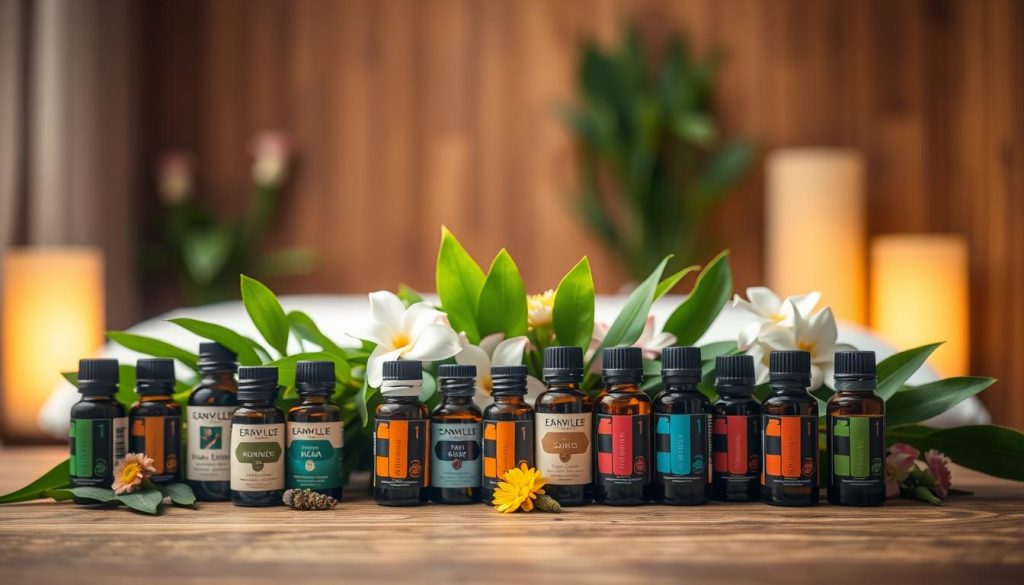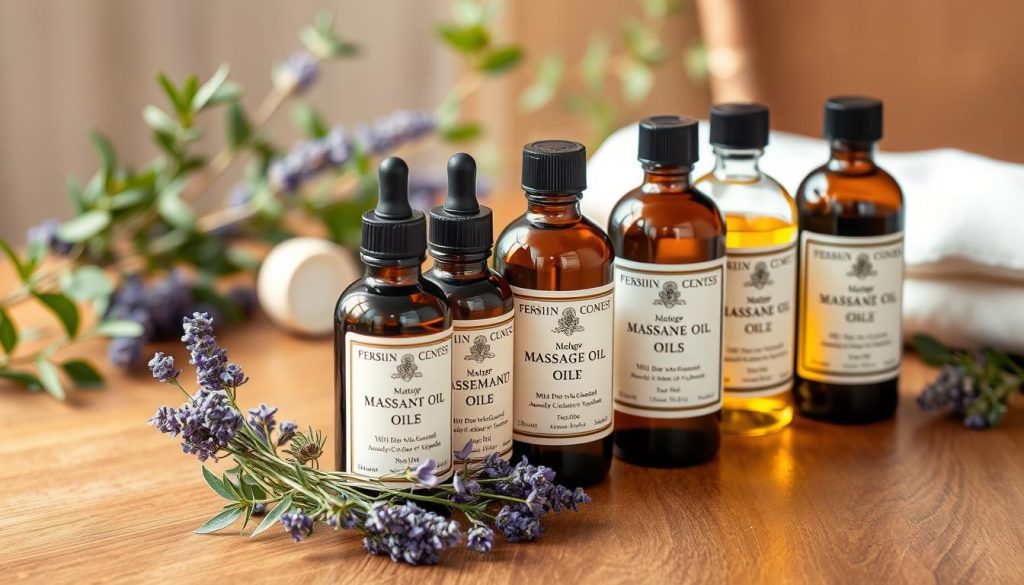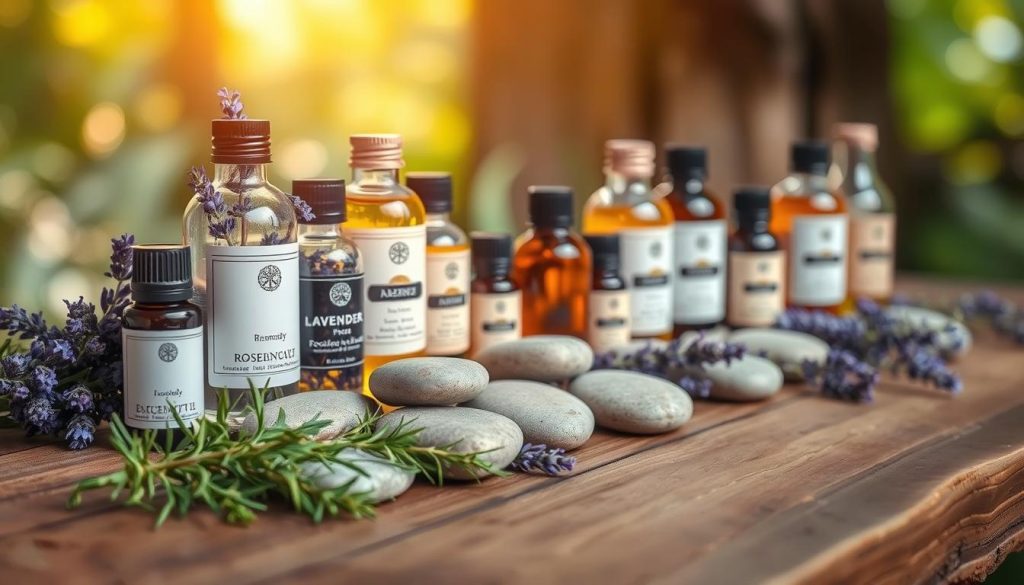Have you ever wondered which blend can turn a quick rub into a calming ritual that truly soothes sore muscles and quiets your mind?
Experts point to ingredients like arnica, vitamin E, calendula, bergamot, and chamomile for results that comfort both body and senses. Use lighter carriers such as jojoba or grapeseed for fast absorption, or choose sunflower-rich luxury blends when you want a rich, gourmand scent that lingers.
At home, simple habits make a big difference: warm a few drops in your palms, start with less, and build as needed. You’ll learn why viscosity matters — glide for gentle relaxation, slight grip for deeper work — and how botanicals like rosemary and geranium refresh both skin and mood.
For a deeper look at ingredient benefits and therapist tips that fit your needs, check this guide on massage oils and their healing properties.
Key Takeaways
- Choose blends with arnica and vitamin E to support recovery and skin repair.
- Pick carrier oils by absorption: jojoba for quick dry, sunflower for rich feel.
- Warm a small amount in your hands and use fewer drops to avoid excess slickness.
- Viscosity affects technique: glide soothes, slight grip aids deeper pressure.
- Botanicals like lavender, rosemary, and chamomile shape scent and purpose.
- At-home options range from affordable shea-lavender to candle-to-oil jojoba formats.
Why Massage Therapists Recommend Specific Oils and Scents Today
Therapists pick blends that deliver clear outcomes, not just a glossy glide. You get formulas with arnica for easing tension and vitamin E to protect skin. Calming botanicals such as calendula and chamomile support gentle relaxation while balancing geranium and rosemary fine-tune mood and focus.
Practitioners match viscosity and absorption to techniques so an oil stays usable through a full session. That keeps each stroke effective without constant reapplication. Unscented, hypoallergenic, water-dispersible options are common in a spa to protect linens and sensitive skin.
- Goal-driven choice: pick ingredients for tension relief, skin care, or calm.
- Workability: correct viscosity helps glide for flowing work and grip for focused pressure.
- Custom scenting: start with an unscented base and add a few drops of essentials for personal aroma.
For research on how scent and touch pair, see this summary of massage and aromatherapy benefits. Thoughtful product choice reduces distraction, extends effects, and helps you leave calmer and more present.
The Most Recommended Massage Oils and Natural Aromas by Massage Therapists
Small drops of specific botanicals can change how your body and mind respond to touch. Reach for targeted blends when you want clear effects: sleep support, clearer breathing, or skin comfort.

Lavender oil for relaxation, stress relief, and better sleep
Lavender eases stress and helps you unwind so sleep comes easier.
Eucalyptus oil for clearer breathing and muscle tension relief
Eucalyptus clears airways and soothes light tension in tired muscles.
Rosemary oil to stimulate circulation and ease fatigue
Rosemary offers a bright lift that supports circulation and mental alertness.
Chamomile oil to calm the mind and soothe skin
Chamomile calms reactive skin while settling a busy mind.
Peppermint oil for cooling relief and mental clarity
Peppermint cools tight spots and sharpens focus during a session.
Geranium, ylang-ylang, frankincense, tea tree
Geranium balances mood and helps skin comfort. Ylang-ylang uplifts emotions gently. Frankincense grounds and deepens relaxation. Tea tree adds hygienic, skin-supportive benefits when used sparingly.
Always dilute essential oils into a carrier. Undiluted use may irritate skin; safe dilution protects comfort and delivers therapeutic benefits.
Top List: Best Massage Oils You Can Use At Home or in the Spa
Picking the right bottle changes how touch, scent, and warmth come together in a session.
Best overall: Multi-botanical blends featuring rosemary, geranium, and lavender. These non-greasy formulas give long bottle life and a balanced profile that works for full-body routines.
Best candle-to-oil experience
Jojoba-based warm oil: Light candle ~15 minutes, pour warm jojoba for an evocative experience. Available scented or fragrance-free to suit home or spa use.
Best drugstore pick
Shea butter + lavender: An affordable option that softens skin and supports quick unwind. Use in a bath or apply post-stress for fast comfort.
Best splurge
Sunflower-rich luxury oil (Helianthus annuus): Rich texture with gourmand vanilla, sweet musk, and woody base. Packaged in glass for an elevated ritual and intense moisturizing effect.
- Choose fragrance-free when sensitivity matters, then add a few drops of aroma you trust.
- Look for pump tops and smart packaging for cleaner, easier application mid-session.
- Scan labels for arnica, vitamin E, or calendula to stack benefits across needs.
| Pick | Base | Best use | Key benefit |
|---|---|---|---|
| Multi-botanical blend | Jojoba/grapeseed mix | Everyday full-body | Non-greasy, long-lasting |
| Candle-to-oil | Jojoba | Ambient solo or couples | Warm pour, cozy experience |
| Drugstore shea + lavender | Shea butter | Quick unwind, bath use | Affordable, softens skin |
| Sunflower luxury | Sunflower seed oil | Gift, ritual splurge | Refined scent, rich moisture |
Best Picks by Need: From Sore Muscles to Dry Skin
Pick targeted blends that answer specific aches, skin needs, or ritual moods. Below are quick, practical options so you grab the right bottle when it matters.

For sore muscles
Arnica-infused blends ease post-exertion discomfort and reduce muscle tension. Pair with sweet almond for steady glide and gentle absorption to ease pain without heavy residue.
For dry skin
A 50/50 mix of sweet almond and sunflower seed oils gives deep hydration with a soft scent. This combo locks in moisture while still allowing good glide during a short massage session.
For a warming effect
Lavender plus rosemary infusions warm tissue and prep muscles for movement. Use in cooler months for cozy relief that also supports circulation and calm.
For mess-free sessions
Solid oil bars melt on contact. Cocoa butter, sweet almond, and apricot kernel create lotion-free glide with minimal spills and easy control for tidy use at home.
For elasticity and tone
Collagen-boosted blends with grapeseed and citrus (lemon, grapefruit) help skin firmness. Antioxidant-rich formulas support daily tone and light absorption for a lifted feel.
For couples
Choose glide-rich almond, jojoba, and coconut blends that balance slip and absorption. These keep moments connected without leaving long-lasting stickiness.
For organic preferences
Certified organic jojoba, coconut, sweet almond, and sunflower bases give clean-label simplicity. They suit sensitive skin and eco-conscious routines.
- Quick guide: reach for arnica when sore muscles need care; use sweet almond + sunflower for dry skin; pick a solid bar for neat sessions.
- Build a small toolkit so the right types fit your weekly needs.
For product options and buying tips, consult this best picks guide or plan an aromatherapy session in Istanbul to try blends hands-on.
How Essential Oils Enhance a Relaxing Massage Session
A few intentional scents can shift a full-body routine from routine care into deep rest. Inhaled and absorbed, essential oils add a scent layer that works with touch to guide felt calm.
Aromatherapy’s role: Scents that influence mood and stress
Lavender and chamomile soothe the nervous system, while peppermint and eucalyptus bring clarity. Ylang-ylang and frankincense help ground emotions and steady breath.
Touch plus aroma: Multi-sensory effects on mind and body
You feel essential oils enhance your massage by pairing steady pressure with scent cues that help your nervous system downshift. This pairing deepens perceived relief and improves overall relaxation.
- You notice oils enhance presence as breathing slows and your mind focuses, making the experience more intentional.
- Blend calm florals with clarifying mints or woods to meet both body and mind in a single session.
- Always dilute each essential oil into a nourishing carrier to protect skin while capturing aromatic benefits.
Take three deep breaths as the warmed oil meets your palms; that moment often becomes the bridge from busy to present.
Choosing the Right Oil: Ingredients, Viscosity, and Absorption
Ingredient choices shape how your session feels long before you warm the bottle.
Ingredients that matter: pick arnica for tension relief, vitamin E to support barrier repair, and calendula or chamomile when you want lasting calm. These additions change therapeutic properties while caring for sensitive skin.
Viscosity vs. technique
Light bases give glide for long, flowing massage work. A touch more body gives grip when you need precise pressure for deep tissue techniques.
Absorption rate
Fast-absorbing formulas can cause repeated stops to add product. You want workability that keeps rhythm steady so effects build naturally.
- Match a single type to session length: light for long relaxation, richer for focused care.
- Consider water-dispersible options in a spa to simplify cleanup and protect linens.
- Keep three bottles: everyday versatile blend, warming option, unscented base for custom scents.
Small refinements—ingredient list, texture, absorbency—turn a good massage into a seamless experience.
Carrier Oils vs. Essential Oils: Building the Perfect Blend
Start by imagining a base that feeds skin while a few drops steer mood and relief.
Carrier choices give glide and nourishment. Sweet almond offers plush slip. Jojoba balances absorption. Coconut provides cushion. Sunflower feels light and silky.
Essential concentrates and targeted properties
Essential oils are powerful. You add them in mindful drops to target relaxation, stress relief, or muscle ease. Always dilute to protect skin and keep aroma clear.
Safe dilution and compatibility
Patch test first on a small area before a full massage session. Choose unscented, hypoallergenic bases—water-dispersible pro formulas suit busy spas and easy laundering.
Practical mixing tips
- Mix carriers to tune texture—grapeseed for light glide, almond for nourishment.
- Start with a neutral base, then use essential oils sparingly to refine scent and outcome.
- Keep therapeutic benefits central: scent should support intent, not distract.
“A few careful drops, a gentle test, and you craft a blend that fits your rhythm.”
| Component | Role | Best for |
|---|---|---|
| Sweet almond | Plush slip, nourishment | Full-body glide |
| Jojoba | Balanced absorption | Sensitive skin, longer sessions |
| Coconut | Cushioning texture | Comfort, warming techniques |
| Sunflower | Light, silky finish | Quick-absorb routines |
For guided choices and booking options that fit Turkish tastes, explore a short list of services at spa sessions.
How to Use Massage Oils Safely for the Best Effects
Before you begin, soften a little oil in your hands so each stroke greets skin with warmth. This small habit helps your touch feel inviting and reduces surprise at first contact.
Less is more. Start with a modest amount, add slowly, and keep control of your techniques. That helps you work around pain instead of forcing through it.
Listen to your skin: if an area reacts, pause, wipe gently, and switch to an unscented carrier before you continue. Always dilute essential oil before skin application to avoid irritation.
- Warm a small amount between palms at session start so touch feels warm, not cold.
- Protect linens with measured use and older towels; pretreat stains with baking soda and water before laundering.
- Rinse after treatment if you prefer, though many blends leave a soft finish that keeps its effect.
- Use pump tops or solid bars to limit spills and keep a calm, spa-like flow.
“A light, mindful approach preserves comfort while you craft lasting relief.”
Pro-Grade Favorites for Massage Therapists Right Now
A carefully chosen back bar turns routine care into a signature client experience.
Sacred Earth Botanicals offers certified organic blends in gallon and 8 oz sizes. Ingredients include sunflower, safflower, olive, jojoba plus non-GMO vitamin E. You get light glide that still supports focused deep work and eco-conscious sourcing for your spa.
Earthlite Pro-Lite delivers an unscented, hypoallergenic base. It uses expeller-pressed safflower and sunflower with coconut, apricot, avocado. Water-dispersible formula makes laundering linens easy while keeping skin comfort high. Add a few drops of essential concentrates to customize scents for each session.
- You stock bulk gallons for busy rooms, small bottles for mobile use to keep your supply consistent.
- You pick clean-label options—nut-free, paraben-free, silicone-free—so more clients feel safe.
- You tune texture across sunflower, jojoba, olive, apricot, coconut to match technique needs.
Pro-grade choices combine reliable slip, simple cleanup, and a neutral canvas for signature blends that elevate every spa experience.
For buying guides and pro tips, see a short list of professional oils for spa salons and practical safety notes from an Istanbul practitioner.
Conclusion
,
Seal your practice with a calm, short ritual that honors skin and mood. Warm a little oil in your palms, set a clear intention, then breathe out to close a session.
Focus on ingredients like arnica, vitamin E, and calendula for steady relief and improved skin comfort. Rotate blends for sore muscles and muscle tension so results stack over time.
Use essential oil drops with care to tune scent for relaxation or clarity—lavender soothes stress; eucalyptus clears focus. For more on professional advantages, see advantages of a masseuse.
Keep one light base, one richer type, and one unscented bottle to build a simple toolkit that supports every relaxing massage routine.






